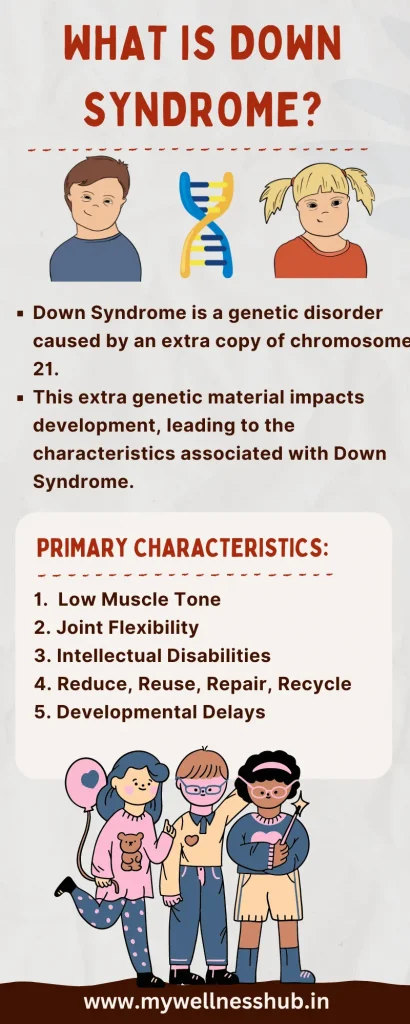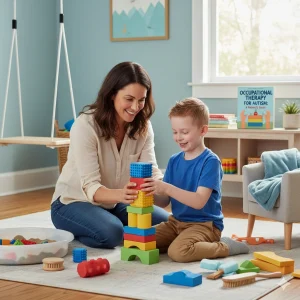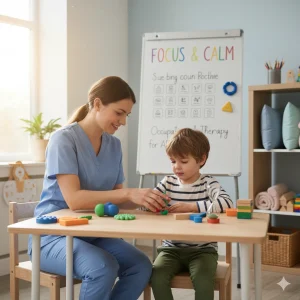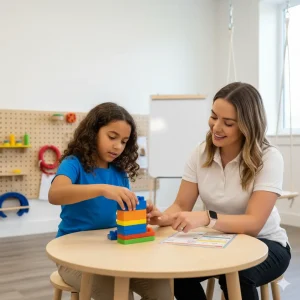Occupational Therapy for Down Syndrome: A Parent’s Guide
By Wellness Hub
Last Updated: August 30, 2024
Welcome! If you’re here, you likely have questions about Down Syndrome and how occupational therapy (OT) can make a difference. Let’s dive into understanding Down Syndrome and explore how OT can unlock potential and improve the quality of life for individuals with this condition.
Introducing Occupational Therapy (OT)
Occupational therapy is a type of therapy that helps people develop, recover, or maintain the daily living and work skills they need. For individuals with Down Syndrome, OT focuses on enhancing their ability to perform daily tasks, improving their motor skills, and increasing their independence. Occupational therapists work closely with individuals and their families to create personalized plans that address specific needs and goals.
What is Down Syndrome?

Down Syndrome is a genetic disorder caused by the presence of an extra chromosome 21. This additional genetic material alters the course of development and causes the characteristics associated with Down Syndrome. It’s a condition that affects people across all races, genders, and socio-economic backgrounds. Each individual with Down Syndrome is unique, but there are common challenges they often face.
Challenges Faced by Individuals with Down Syndrome
People with Down Syndrome often experience:
- Motor Skill Delays: Many children with Down Syndrome have delayed development of both fine and gross motor skills. This means they may take longer to learn how to crawl, walk, or use their hands effectively.
- Low Muscle Tone: Also known as hypotonia, low muscle tone can make physical activities more challenging and affect posture and balance.
- Developmental Delays: Intellectual and developmental delays are common, impacting learning, communication, and social interaction.
Understanding Down Syndrome
Down Syndrome is a genetic disorder caused by the presence of an extra copy of chromosome 21. This condition, also known as Trisomy 21, affects individuals across various demographics, and each person with Down Syndrome is unique. However, there are some common characteristics that are typically observed.
Primary Characteristics of Down Syndrome
- Low Muscle Tone (Hypotonia): Individuals with Down Syndrome often have low muscle tone, which means their muscles may appear floppier than those without the condition. This can affect their ability to develop motor skills and maintain posture.
- Joint Flexibility: Another characteristic is increased joint flexibility, also known as ligamentous laxity. This means their joints may be more flexible than usual, which can sometimes lead to challenges in stability and movement.
- Intellectual Disabilities: People with Down Syndrome usually experience some level of intellectual disability, which can range from mild to moderate. This impacts their cognitive abilities, learning pace, and overall intellectual development.
- Developmental Delays: Developmental delays are common in individuals with Down Syndrome. These delays can affect various areas, including motor skills, speech and language, and social interactions. Children with Down Syndrome might take longer to reach milestones such as sitting, walking, and talking.
The Importance of Early Intervention
Early intervention is crucial for children with Down Syndrome. The earlier they receive support and therapeutic strategies, the better their developmental outcomes can be. Tailored therapeutic approaches, like occupational therapy, can significantly enhance their ability to perform daily tasks and improve their quality of life.
The Role of Occupational Therapy in Down Syndrome
Occupational therapy (OT) is a vital form of support for individuals with Down Syndrome. It involves therapeutic strategies and interventions designed to help people develop, recover, or maintain the skills needed for daily living and working. For those with Down Syndrome, occupational therapy can make a significant difference in their ability to lead more independent and fulfilling lives.
What is Occupational Therapy?
Occupational therapy focuses on enhancing the ability of individuals to perform daily activities through therapeutic practices. This includes improving fine and gross motor skills, enhancing self-care abilities, integrating sensory experiences, and supporting social and emotional development. Occupational therapists work closely with individuals and their families to create customized plans that address specific challenges and goals.
Goals of Occupational Therapy for Down Syndrome
- Developing Motor Skills (Fine and Gross): Occupational therapists help individuals with Down Syndrome improve their motor skills. Fine motor skills involve the use of small muscles, such as those in the hands and fingers, for tasks like writing or buttoning a shirt. Gross motor skills involve larger muscles used for activities like walking, jumping, or balancing. By focusing on exercises and activities that build these skills, occupational therapy helps individuals gain better control and coordination.
- Enhancing Self-Care Skills: Self-care skills are essential for independence. Occupational therapy assists individuals with Down Syndrome in mastering tasks such as dressing, eating, toileting, and personal hygiene. By breaking down these tasks into manageable steps and practicing them regularly, therapists help individuals gain confidence and autonomy in their daily lives.
- Improving Sensory Integration: Many individuals with Down Syndrome experience sensory processing challenges. This means they might have difficulty responding appropriately to sensory input, such as touch, sound, or movement. Occupational therapists use sensory integration techniques to help these individuals process and respond to sensory information more effectively. This can involve activities that enhance their ability to focus, manage their reactions, and engage with their environment.
- Supporting Social and Emotional Development: Social and emotional skills are crucial for forming relationships and navigating social situations. Occupational therapy supports individuals with Down Syndrome in developing these skills through activities that promote interaction, communication, and emotional regulation. This can include role-playing exercises, group activities, and strategies for managing emotions and behaviors.
Tailored OT Programs Based on Individual Assessments
One of the key strengths of occupational therapy is its personalized approach. Occupational therapists conduct thorough assessments to understand the unique needs and abilities of each individual with Down Syndrome. These assessments guide the development of customized intervention plans that address specific challenges and leverage individual strengths. By tailoring programs to each person’s needs, occupational therapy ensures that interventions are both effective and meaningful.
Common Occupational Therapy Interventions
Occupational therapy interventions are tailored to address the unique needs of individuals with Down Syndrome, focusing on enhancing their daily living skills and overall quality of life. Let’s explore some common interventions used in occupational therapy to support these individuals.
Motor Skills Development
Fine Motor Skills: Improving fine motor skills is essential for daily tasks such as writing, buttoning clothes, and using utensils. Occupational therapists use various activities to enhance dexterity and hand-eye coordination. For example, children may be encouraged to play with small items like beads, buttons, or cheerios. These activities help strengthen their grip and improve their ability to manipulate objects. Therapists might also use tools like tweezers or clothespins to add an extra challenge and promote precision.
Gross Motor Skills: Developing gross motor skills involves exercises that strengthen large muscle groups and improve overall coordination. Activities such as crawling, wheelbarrow walking, and animal walks (like bear crawls or crab walks) are often used. These exercises help build core strength, enhance balance, and promote better movement control. For example, crawling through tunnels or climbing over obstacles can be both fun and beneficial for developing gross motor skills.
Self-Care Skills
Teaching Self-Care Tasks: Occupational therapists focus on teaching essential self-care tasks to help individuals with Down Syndrome become more independent. This includes dressing, eating, and toileting. Therapists often break these tasks into smaller, manageable steps and use repetition to help individuals learn. For instance, they might use visual aids or hand-over-hand guidance to teach a child how to button a shirt or brush their teeth. Consistent practice and positive reinforcement are key to mastering these skills.
Sensory Integration
Sensory Activities: Many individuals with Down Syndrome have sensory processing challenges. Occupational therapy incorporates sensory activities to help them respond appropriately to different stimuli. Activities might include using textured materials, playing with sensory bins filled with items like rice or sand, or engaging in swinging or spinning exercises. These activities help improve sensory processing and promote better focus and engagement.
Tools for Sensory Integration: Occupational therapists may also use specific tools to aid sensory integration. Weighted vests or blankets can provide calming pressure, helping individuals feel more grounded. Noise-reducing headphones can be useful in managing auditory sensitivities, allowing children to focus better in noisy environments. These tools are often used during therapy sessions and recommended for use at home or school as needed.
Social and Emotional Support
Enhancing Social Interactions: Social and emotional development is crucial for individuals with Down Syndrome. Occupational therapy includes strategies to improve social skills and emotional regulation. Activities like group play, role-playing, and social stories can help children learn how to interact with peers, express their emotions, and develop empathy. For example, therapists might use puppets or dolls to model appropriate social behaviors and practice conversational skills.
Promoting Peer Relationships: Therapists also focus on activities that promote peer relationships and communication skills. Group activities, such as cooperative games or team projects, encourage children to work together, share, and take turns. These activities help build friendships and improve their ability to communicate effectively with others.
Occupational Therapy Goals and Activities
| Goal | Activity Example |
|---|---|
| Improve Fine Motor Skills | – Bead stringing: Encourages hand-eye coordination and fine motor control by threading beads onto a string. – Button sorting: Develops dexterity by sorting and manipulating buttons of various sizes and shapes. |
| Enhance Gross Motor Skills | – Crawling: Builds core strength and coordination by having the child move on hands and knees. – Wheelbarrow walking: Strengthens the upper body and improves balance by walking on hands while someone holds the legs. |
| Develop Self-Care Skills | – Dressing: Teaches independence by practicing putting on clothes, fastening buttons, and tying shoelaces. – Toileting: Helps in establishing routines and skills needed for using the bathroom independently. – Eating: Improves self-feeding skills using utensils, cutting food, and drinking from a cup. |
| Improve Sensory Processing | – Sensory bins: Uses materials like rice, sand, or water to provide tactile sensory experiences that help with sensory integration. – Weighted blankets: Provides calming pressure to help individuals feel more grounded and secure. |
| Support Social Skills | – Group play: Encourages interaction, sharing, and communication through cooperative games and activities. – Role-playing: Enhances social understanding and emotional regulation by acting out different social scenarios. |
The Process of Occupational Therapy
Occupational therapy is a structured yet personalized process designed to meet the unique needs of each individual with Down Syndrome. Understanding this process can help parents and caregivers know what to expect and how best to support their loved ones.
Assessment
The first step in the occupational therapy process is the initial evaluation. During this assessment, an occupational therapist gathers comprehensive information about the individual’s abilities and challenges. This involves a detailed observation and interaction with the child to understand their current level of functioning.
Skills Assessed:
- Motor Skills: The therapist evaluates both fine motor skills (e.g., hand and finger movements) and gross motor skills (e.g., walking, jumping).
- Sensory Skills: Sensory processing abilities are assessed to understand how the child responds to different sensory inputs, such as touch, sound, and movement.
- Cognitive Skills: The evaluation includes an assessment of cognitive functions like memory, attention, and problem-solving abilities.
- Social Skills: Social interactions, communication skills, and emotional regulation are observed to determine the child’s social development.
Individualized Plan
Based on the assessment results, the occupational therapist creates a personalized intervention plan. This plan is tailored to address the specific needs and goals of the individual. The therapist sets achievable objectives and designs activities that target the identified areas of improvement.
Creating the Plan:
- Personalization: The intervention plan is customized to fit the individual’s unique challenges and strengths. For example, if a child has difficulty with fine motor skills, activities like bead stringing or using playdough may be included.
- Goal Setting: Clear, measurable goals are established to track progress. These goals might include improving the ability to dress independently, enhancing hand-eye coordination, or developing better social skills.
Involvement of Parents, Caregivers, and Health Professionals:
- Collaboration: The success of occupational therapy greatly depends on the involvement of parents, caregivers, and other health professionals. Therapists often work closely with families to ensure that therapeutic activities are reinforced at home.
- Training and Support: Occupational therapists provide training and support to parents and caregivers, teaching them techniques to help their child practice new skills. This collaborative approach ensures that the child receives consistent support across different environments.
- Interdisciplinary Team: Often, the occupational therapist will coordinate with other health professionals, such as speech therapists, physical therapists, and educators, to provide a holistic approach to the child’s development. This team effort ensures all aspects of the child’s growth are addressed comprehensively.
Assessment Areas in Occupational Therapy
| Skill Area | Examples of Assessment |
|---|---|
| Motor Skills | – Fine Motor Skills: Assessing the ability to perform tasks requiring small muscle movements, such as grasping objects, writing, and buttoning. – Gross Motor Skills: Evaluating the ability to perform tasks involving large muscle groups, such as walking, jumping, and balance. |
| Sensory Skills | – Response to Sensory Inputs: Evaluating how the individual responds to different sensory stimuli, such as touch, sound, light, and movement. This includes assessing sensitivities or seeking behaviors towards sensory input. |
| Cognitive Skills | – Memory: Testing short-term and long-term memory functions. – Attention: Assessing the ability to maintain focus on tasks and shift attention when needed. – Problem-Solving: Evaluating the capacity to solve problems, make decisions, and perform tasks that require cognitive processing. |
| Social Skills | – Social Interactions: Observing how the individual interacts with peers and adults, including turn-taking, sharing, and initiating conversations. – Communication: Assessing verbal and non-verbal communication skills, including understanding and expressing language, gestures, and facial expressions. |
Benefits of Occupational Therapy for Down Syndrome
Occupational therapy (OT) offers numerous benefits for individuals with Down Syndrome, significantly enhancing their ability to perform daily tasks and improving their overall quality of life. Let’s explore the key benefits that OT brings to individuals with Down Syndrome and their families.
Improved Independence
One of the primary goals of occupational therapy is to help individuals with Down Syndrome perform daily tasks independently. Through targeted interventions and personalized strategies, occupational therapists teach essential skills such as dressing, eating, and toileting. By breaking down complex tasks into manageable steps, therapists make it easier for individuals to learn and practice these skills. For example, learning to dress involves mastering buttons, zippers, and tying shoelaces, which are taught through repetitive practice and positive reinforcement.
Achieving independence in these daily activities boosts confidence and self-esteem, enabling individuals to feel more capable and self-sufficient. This independence extends beyond personal care tasks to include participation in household chores, recreational activities, and social interactions.
Enhanced Quality of Life
Occupational therapy significantly enhances the overall quality of life for individuals with Down Syndrome. By improving motor skills, sensory integration, and self-care abilities, OT helps individuals engage more fully in their daily lives. Better motor skills enable them to participate in activities like playing sports, drawing, or cooking, which can be both enjoyable and fulfilling.
Additionally, occupational therapy supports the development of social and emotional skills. Enhanced communication and social interaction abilities allow individuals to build stronger relationships with family members, peers, and community members. This social engagement is crucial for emotional well-being and fosters a sense of belonging and acceptance.
The cumulative effect of these improvements is a higher quality of life, characterized by greater participation in everyday activities, increased opportunities for social interaction, and an overall sense of accomplishment and happiness.
Long-term Impact
The benefits of occupational therapy extend well into adolescence and adulthood, preparing individuals with Down Syndrome for vocational skills and job readiness. As teenagers, they learn practical skills that are essential for employment, such as time management, task organization, and workplace etiquette. Occupational therapists work with individuals to identify their strengths and interests, guiding them toward suitable career paths.
For example, a teenager with a talent for art might be encouraged to explore opportunities in graphic design, while another with strong organizational skills could be guided towards administrative roles. The goal is to equip individuals with the skills and confidence needed to pursue meaningful and rewarding careers.
Tips for Parents and Caregivers
Parents and caregivers play a crucial role in the success of occupational therapy for individuals with Down Syndrome. Here are some valuable tips to help you navigate this journey and maximize the benefits of therapy.
Finding a Good Occupational Therapist
Selecting a qualified occupational therapist (OT) is the first step towards effective therapy. Here are some tips to help you find the right OT for your child:
- Research Credentials and Experience:
- Ensure the therapist is licensed and certified by relevant professional bodies.
- Look for therapists with experience in working with children with Down Syndrome.
- Seek Recommendations:
- Ask for recommendations from your pediatrician, other parents, or support groups.
- Read reviews and testimonials from other families who have worked with the therapist.
- Evaluate Communication and Approach:
- Meet with potential therapists to discuss their approach and philosophy.
- Choose a therapist who communicates well and makes you and your child feel comfortable.
- Consider Specialization:
- Some OTs specialize in certain areas, such as sensory integration or motor skills development. Find a therapist whose expertise aligns with your child’s needs.
Supporting Therapy at Home
Supporting your child’s therapy goals at home is essential for reinforcing what they learn during sessions. Here are some activities and strategies you can use:
- Create a Routine:
- Establish a consistent daily routine that includes time for therapy-related activities.
- Use visual schedules to help your child understand and anticipate the day’s activities.
- Engage in Fine Motor Activities:
- Encourage play with small items like beads, buttons, or puzzles to strengthen fine motor skills.
- Use everyday tasks, like cooking or arts and crafts, to practice these skills.
- Promote Gross Motor Skills:
- Include physical activities like climbing, jumping, or playing on swings to build gross motor skills.
- Set up obstacle courses at home to make exercise fun and engaging.
- Incorporate Sensory Play:
- Provide sensory-rich activities, such as playing with playdough, sand, or water.
- Use tools like weighted blankets or noise-reducing headphones if your child has sensory sensitivities.
Collaborating with Professionals
Collaboration between parents, caregivers, and professionals is key to a successful therapy program. Here’s how to foster effective teamwork:
- Maintain Open Communication:
- Regularly communicate with your child’s occupational therapist about progress and challenges.
- Share any observations from home that could help tailor the therapy sessions.
- Participate in Sessions:
- Whenever possible, attend therapy sessions to understand the techniques and strategies being used.
- Ask questions and learn how to apply these strategies at home.
- Work with Educators:
- Collaborate with your child’s teachers to integrate therapy goals into the school environment.
- Ensure that educators are aware of any special accommodations or tools your child needs.
- Join Support Groups:
- Engage with other parents and caregivers through support groups or online communities.
- Share experiences, exchange tips, and provide mutual support
Conclusion
Occupational therapy is essential in helping individuals with Down Syndrome reach their full potential. It focuses on developing motor skills, improving self-care abilities, enhancing sensory integration, and supporting social and emotional growth. These therapies help individuals become more independent and improve their overall quality of life. By tailoring the approach to each person’s unique needs and strengths, occupational therapy ensures effective and meaningful support.
If you have a loved one with Down Syndrome, professional occupational therapy services can make a big difference. At Wellness Hub, we offer access to qualified occupational therapists and additional resources to support families. Our goal is to help you find the best strategies to support your loved one. For more information and assistance, visit our Wellness Hub Occupational Therapy page. By using occupational therapy, you can help your loved one live a more empowered and joyful life.
Frequently Asked Questions:
1. What is the primary goal of occupational therapy for individuals with Down Syndrome?
The primary goal of occupational therapy for individuals with Down Syndrome is to help them develop the skills necessary for independent daily living. This includes improving motor skills, self-care abilities, sensory processing, and social interactions.
2. How does occupational therapy improve motor skills in children with Down Syndrome?
Occupational therapy improves motor skills by using targeted activities and exercises. For fine motor skills, therapists might use tasks like bead stringing or playing with buttons. For gross motor skills, activities like crawling, climbing, and wheelbarrow walking are used to build strength and coordination.
3. Can occupational therapy help with sensory processing issues in Down Syndrome?
Yes, occupational therapy can help individuals with Down Syndrome who have sensory processing issues. Therapists use sensory integration techniques, such as playing with textured materials or using weighted blankets, to help children respond appropriately to sensory stimuli.
4. How can parents support occupational therapy at home?
Parents can support occupational therapy at home by creating a consistent routine, engaging in fine motor and gross motor activities, and incorporating sensory play. It’s also helpful to maintain open communication with the therapist and follow their guidance for home-based activities.
5. What should I look for when choosing an occupational therapist for my child with Down Syndrome?
When choosing an occupational therapist, look for someone who is licensed and experienced in working with children with Down Syndrome. Seek recommendations, evaluate their communication style, and ensure they offer a personalized approach tailored to your child’s specific needs.
6. How does occupational therapy enhance the quality of life for individuals with Down Syndrome?
Occupational therapy enhances the quality of life by helping individuals develop essential life skills, improve their independence, and engage more fully in daily activities. This includes better motor skills, self-care abilities, social interactions, and overall emotional well-being.
7. What long-term benefits can occupational therapy provide for teenagers with Down Syndrome?
For teenagers with Down Syndrome, occupational therapy can prepare them for vocational skills and job readiness. It helps them develop practical skills, such as time management and task organization, which are essential for successful employment and independent living.
8. How do occupational therapists create individualized intervention plans?
Occupational therapists create individualized intervention plans based on thorough assessments of the individual’s motor, sensory, cognitive, and social skills. They set personalized goals and design activities that target specific areas of improvement, involving parents and other professionals in the process.
9. Is early intervention important for children with Down Syndrome?
Yes, early intervention is crucial for children with Down Syndrome. Starting occupational therapy early can significantly improve developmental outcomes by addressing challenges and building essential skills during critical periods of growth.
10. Where can I find more information and resources on occupational therapy for Down Syndrome?
For more information and resources on occupational therapy for Down Syndrome, visit the Wellness Hub Occupational Therapy page. Our team is dedicated to providing support and guidance to families seeking the best therapeutic strategies for their loved ones.
About Author
Prapoorna Mangalampalli
M.Sc., M.A., (Dual Masters in Psychology and Senior Content Developer) – Counselor (6+ years of experience)
Prapoorna, with dual Master’s degrees in Psychology and English and over 6 years of experience, elevates human experiences through insightful counseling. She excels in online therapy, marital relationships, child family, and career counseling. At Wellness Hub, she thrives in a team environment, valuing innovation, compassion, and client success.
Book your Free Consultation Today
Parent/Caregiver Info:
Client’s Details:
* Error Message









